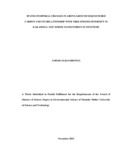SPATIO-TEMPORAL CHANGES IN ABOVE-GROUND SEQUESTERED CARBON AND ITS RELATIONSHIP WITH TREE SPECIES DIVERSITY IN KAKAMEGA AND NORTH NANDI FOREST ECOSYSTEMS
Abstract
Monitoring aboveground carbon (AGC) dynamics and tree diversity functionality relationships is crucial to understanding the role of vegetation in implementing climate change mitigation strategies and promoting sustainable forest management. Despite the continued negative effects of climate change on the biophysical environments, forests that constitute crucial carbon sinks for mitigating climate change continue to reduce in size due to anthropogenic degradation. This study sought to determine the spatial and temporal changes in Aboveground Carbon (AGC) stocks and its relationship to tree species diversity in Kakamega and North Nandi Forests. Specifically, the study (i) determined the spatial changes in AGC stocks (ii) assessed the temporal changes in AGC stocks (iii) evaluated relationships between tree species diversity and AGC stocks. Four study sites were chosen in each of the forest types (least disturbed, plantations and disturbed) for data collection. In each forest type, four 50m x50m quadrat were established within which mature trees were sampled for diameter, height, and wood density, while 192 - 1m x1m plots were laid for herbs and shrubs sampling. In every 50mx50m plot established, all trees were counted, and identified to species level. Tree diameter was measured using the diameter tape at 1.3m above the ground for trees of DBH≥5cm.Tree height was estimated using a Suunto clinometer while wood density obtained from wood density database. Improved Chave allometric equation for the African moist tropical forests (W=F.ρD2H) was used to estimate tree biomass which was converted to AGC. Landsat satellite images from the United States Geological Survey’s Landsat archive for the period 1988 to 2020 were used to obtain temporal biomass from which temporal AGC was determined. SPSS version 25 was used to analyze the data. Kruskal-Wallis and Mann Whitney U tests were performed to assess the variation in carbon and tree diversity between forests and forest status. Correlation was performed to analyze the relationship between tree diversity and AGC. Results showed that Kakamega Forest had the highest mean AGC (157.93 ± 26.91 t ha-1) while North Nandi Forest had (97.83 ± 19.89 t ha-1). Least disturbed forest areas recorded the highest mean AGC (65.96 ± 8.56t ha-1), followed by plantation sites (26.69 ± 1.12 t ha-1), while disturbed forest sites had (3.26 ±0.11t ha-1). This was statistically significant (X2(2, N=24) =17.47, p= 0.001). Management regime, and variation in tree species diversity were suspected to play key role in carbon variations. Temporally, AGC showed a decadal increasing-decreasing pattern that positively correlated with vegetation cover changes in both Kakamega (r=0.85) and North Nandi (r=0.72) Forests. However, the correlations were not statistically significant (p>0.05). Shannon Wiener’s diversity index revealed a higher tree species diversity in Kakamega Forest (H´= 1.82 ± 0.95) relative to North Nandi Forest ‘s (H´= 1.24 ± 0.88). A significant positive correlation between the AGC and tree species diversity (r= 0.62, p< 0.05) was recorded. Management regime, and abiotic factors were suspected to play key role in diversity variations. Conclusively, Kakamega and North Nandi forests vary spatially and temporally in their AGC stock. Tree species diversity positively affects carbon stock of these two forests. Mixed indigenous plantations should be adopted in restoration of disturbed forest areas. A holistic management approach involving all players and focused on alternative livelihood options should be prioritized in forest management. Further studies should investigate the below ground carbon stocks to fully understand the role forest compartments play in forest carbon dynamics.

